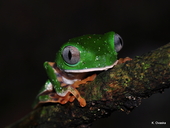|
Description
Males 44-54 mm, females
60 mm. The dorsum is uniform green.
The flanks and inner surfaces of legs,
hands, and feet are orange with vertical
black stripes. Ventral coloration is white
or orange. The iris is silvery or grayish (Lima et al. 2005).
Distribution and Habitat
Country distribution from AmphibiaWeb's database: Bolivia, Brazil, Colombia, Ecuador, French Guiana, Guyana, Peru, Suriname, Venezuela
Northern South America: eastern Ecuador, eastern Peru, southern Colombia, southern and eastern Venezuela, Guyana, Suriname, French Guiana, Brazil, northern Bolivia. Occurs in pristine tropical rainforest up to 500 m asl, usually found on trees or shrubs around pools during the wet season (La Marca et al. 2008). Life History, Abundance, Activity, and Special Behaviors
The species is
arboreal and nocturnal. Males call
from trees or shrubs near ponds
mainly between December and May.
Clutches contain about 70
unpigmented eggs in a gelatinous
mass that are deposited in leaf nests
over ponds. Tadpoles fall into the
water after hatching, where they
develop until metamorphosis (Lima et al. 2005). Trends and Threats
Phyllomedusa tomopterna requires pristine rainforest. This species is most common in Suriname; elsewhere in its range it is not considered common. It is not considered threatened except where individual populations are impacted by deforestation. Its range overlaps with a number of protected areas: in Brazil, it is found in the Reserva Florestal Adolpho Ducke; In Ecuador, it is found in the Parque Nacional Yasuní, Reserva de Producción de Faunística Cuyabeno, and Reserva Biológica Limoncocha; in Peru it is found in Parque Nacional Manu; in Venezuela, it is found in the Reserva Forestal Imataca. The Venezuelan population in the Reserva Forestal Imataca may become endangered as logging proceeds (La Marca et al. 2008). Possible reasons for amphibian decline General habitat alteration and loss
Habitat modification from deforestation, or logging related activities
Comments
First described by Cope (1868).
References
Cope, E. D. (1868). ''An examination of the Reptilia and Batrachia obtained by the Orton expedition to Equador and the upper Amazon, with notes on other species.'' Proceedings of the Academy of Natural Sciences of Philadelphia, 20, 96-140.
La Marca, E., Azevedo-Ramos, C., Coloma, L. A., and Ron, S. 2008. Phyllomedusa tomopterna. In: IUCN 2010. IUCN Red List of Threatened Species. Version 2010.4. . Downloaded on 14 March 2011.
Lima, A. P., Magnusson, W. E., Menin, M., Erdtmann, L. K., Rodrigues, D. J., Keller, C., and Hödl, W. (2005). Guia de Sapos da Reserva Adolpho Ducke, Amazonia Central. Átterna Design Editorial, Manaus. [link]
Originally submitted by: Albertina P. Lima, William E. Magnusson, Marcelo Menin, Luciana K. Erdtmann, Domingos J. Rodrigues, Claudia Keller, Walter Hödl (first posted 2007-11-27)
Edited by: Kellie Whittaker (2011-03-14)Species Account Citation: AmphibiaWeb 2011 Phyllomedusa tomopterna: Tiger-striped Leaf Frog <https://amphibiaweb.org/species/664> University of California, Berkeley, CA, USA. Accessed May 13, 2025.
Feedback or comments about this page.
Citation: AmphibiaWeb. 2025. <https://amphibiaweb.org> University of California, Berkeley, CA, USA. Accessed 13 May 2025.
AmphibiaWeb's policy on data use.
|
